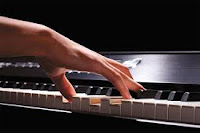A student asks about showing the melody notes in the first movement of the Moonlight Sonata. Sometimes this involves an interval exceeding an octave. We are talking here, of course, about voicing.

Voicing chords is the way we give color to our performances. Imagine combining colors of the white and black keys. Gray. Nothing but gray. I once saw a New Yorker cartoon that brilliantly illustrates what we are after as pianists. There was an enormous black grand piano on a stage with black curtains at the sides and upstage. The pianist wore black tails. Such a dreary image. But from inside the raised piano lid came a staff, a musical rainbow with notes of red, blue yellow, you name it.

If we attack the all keys under our hands with the same weight we get sameness, gray. But if we listen well for relationships, we can begin to feel a difference in weight relationships. This can be applied to any part of a chord, not just the melody. Perhaps there is an inner voice. Or maybe there is one note, or two, that might be shown in the way that a French horn in the orchestra might sound—just for a moment of fleeting color.
A contributor to the discussion wrote: Dorothy Taubman had a very interesting way of teaching voicing to her students. One of the things she used to say in master class was to play the top note with your finger, and the other notes with your arm. She also used to have her students play the top note separately, producing a full, ringing sound. Then she would have the student play the other notes separately with a quieter, more transparent sound. Once the two sounds could be produced consistently and successfully with their separate fingers, then she had the student play all the fingers together trying to produce their respective colors. If it didn't work right away, she would have the student alternate "separate" and "together" until the voicing was very pronounced.

How refreshing it was to hear someone quote Taubman. I thought I was the only one who heard her lectures—all of them many times—and participated in her master classes. (My teacher, after I finished my MS, was Golandsky.) I like the idea of finger vs arm when voicing to the outside of the hand. I've noticed a problem over the years, though, with students falling into the trap of disconnecting the melody note from the supporting chord, a sort of rolled effect. I like to use the imagery of the melody finger digging slightly deeper than the other fingers as if making indentations in wet sand. This, of course, is just another way of talking about distributing the weight. This concept can be applied to any part of a group of notes. Try practicing it on a triad, feeling the weight shift on each note in succession with each iteration of the triad.
No comments:
Post a Comment